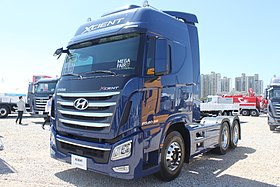Hyundai Xcient
The Hyundai Xcient is a South Korean truck made by Hyundai Motor Company. It was presented at the Seoul Motor Show 2013 as the successor of Hyundai Trago.[5]
| Hyundai Xcient | |
|---|---|
 | |
| Overview | |
| Also called | Hyundai Trago Xcient Hyundai Super Truck Xcient (Belize) Inokom Xcient |
| Production | Jeonju, South Korea (Hyundai Motors Jeonju)[1]
Ziyang, China (Sichuan Hyundai)[2][3] Kaliningrad, Russia (Avtotor)[4] |
| Powertrain | |
| Engine | H engine (D6HB38) (Max. power: 380 ps, Max. Torque: 160 kg·m, Displacement: 9,960 cc, Euro 3), Powertec engine (D6CC41) (Max. power: 410 ps, Max. Torque: 188 kg·m, Displacement: 12,920 cc, Euro 4) Q engine (D6AC) (Max. power: 340 ps, Max. Torque: 140 kg·m, Displacement: 11,149 cc, Euro 1) |
| Chronology | |
| Predecessor | Hyundai Trago |


Configuration and technology
All previous Hyundai commercial vehicles were either based on Mitsubishi Fuso Truck and Bus Corporation models, or were based on Japanese design, like its predecessor, Trago. The Xcient was developed during 3 years at a cost of 200 billion Won. Compared its predecessor, it features increased cabin space and modernized driver comfort equipment.[6]
At introduction , Hyundai offers two engine variants, a 10.1-liter (common-rail injection) diesel engine with 414 hp and a top-of-the-line 12.7-liter version with 520 hp.[6] The Xcient is available with engine powers ranging from 360 to 520 hp in Euro III and Euro IV variants, with a 12 or 16 speed dual-clutch transmission.[3] The Xcient offers a total interior volume of more than 1,000 liters for the 3.92 meter high roof version.
A level 3 autonomous version is in development by Hyundai.[7]
Hydrogen fuel versions
In 2020, Hyundai, in a joint venture with Swiss company H2 Energy, started mass manufacturing hydrogen powered 34-ton cargo trucks under the brand Xcient. The vehicles are able to travel 400 kilometres (250 mi) on a full tank and they take 8 to 20 minutes to fill up.[8]
References
- "Hyundai Commercial Vehicle TV - Hyundai Commercial Vehicle". trucknbus.hyundai.com.
- "Hyundai Motor changes Chinese commercial vehicle partner to Sichuan Energy - Pulse by Maeil Business News Korea". pulsenews.co.kr.
- "[Hot Item] Hyundai Xcient 6X4 Tractor Truck with 440 HP Engine". Made-in-China.com.
- "Avtotor will start the production of Hyundai Xcient heavy trucks". 25 September 2018.
- München, Trucker, Verlag Heinrich Vogel, Springer Fachmedien. "Hyundai Xcient: Fernost-Offensive". www.trucker.de.
- https://www.motortrend.com/news/seoul-truck-heavy-duty-hyundai-xcient-gets-improved-features-fuel-economy-349329/
- Edelstein, Stephen. "Hyundai Tests Autonomous Semitruck Tech on South Korean Highway". The Drive.
- "Hyundai Starts Mass Production of Hydrogen Trucks". Chosun Ilbo. Retrieved 2020-07-12.